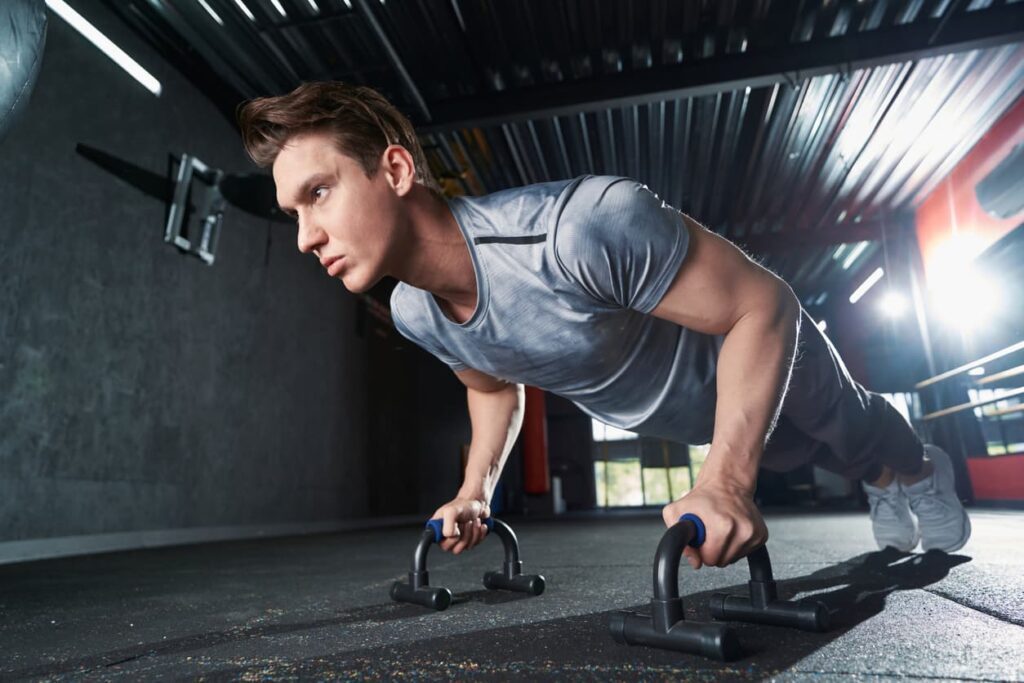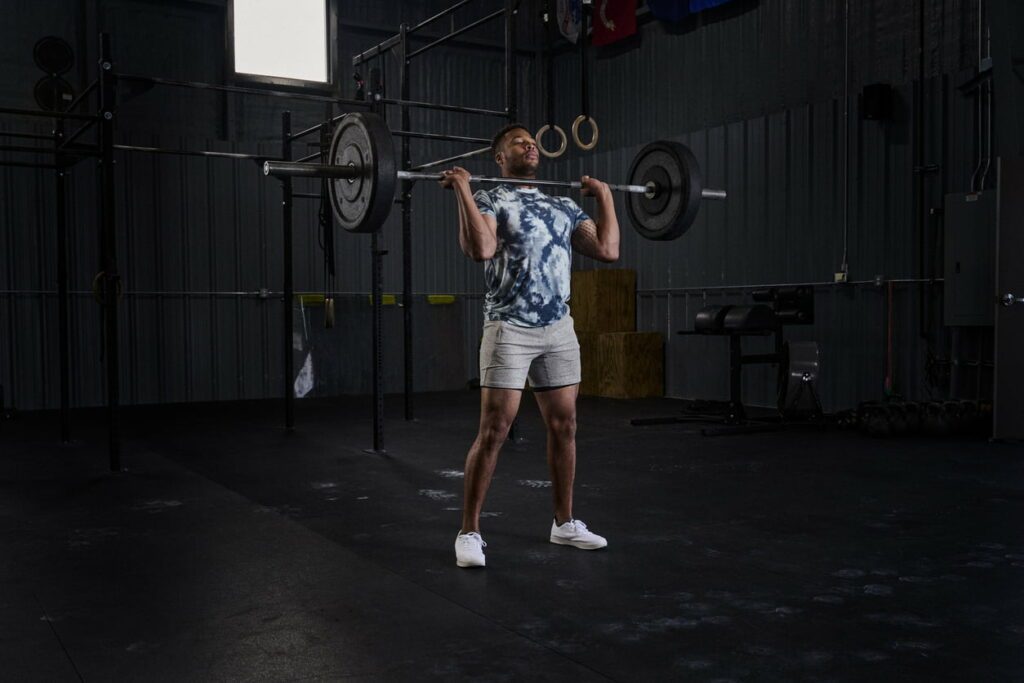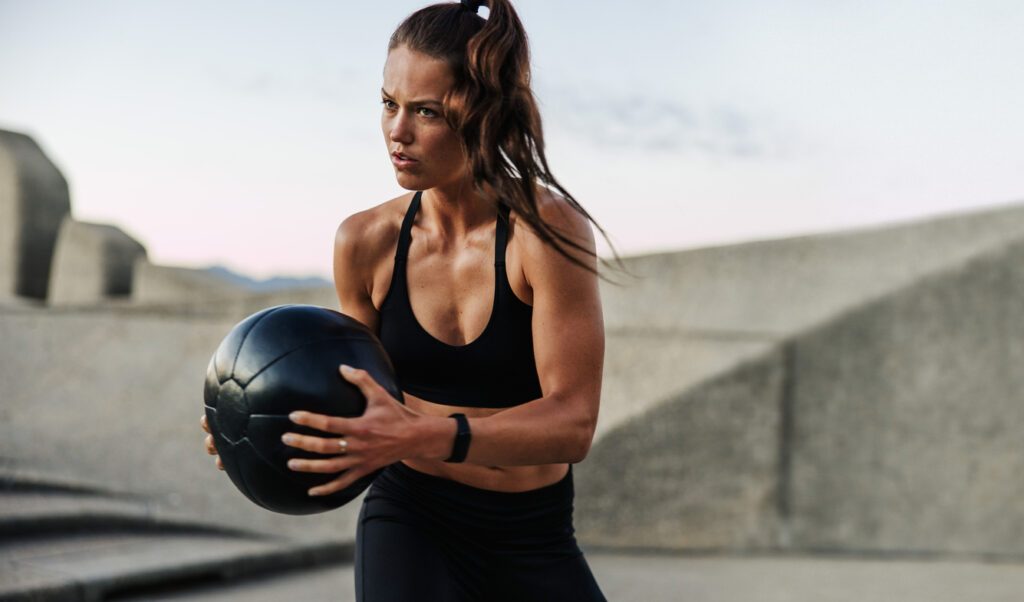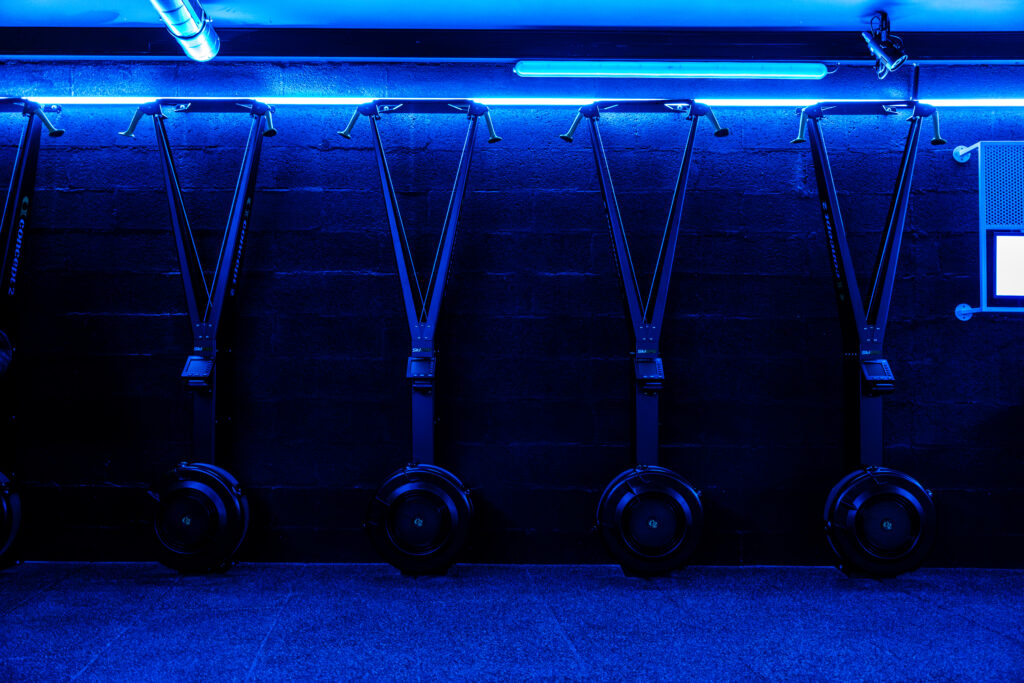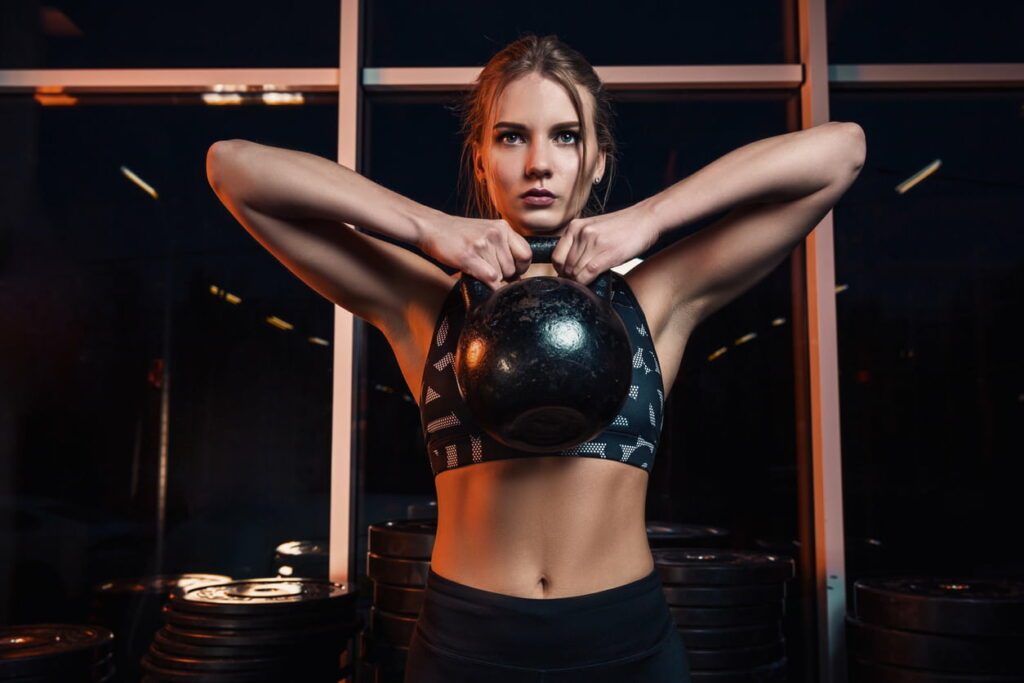
Summary
Welcome / Welcome / Tips for getting started / HIIT upper body: the guide to a sculpted bust
HIIT upper body: the guide to a sculpted bust
Many of you are looking for ways to sculpt and strengthen the upper part of your figure. HIIT is the key to this. Specifically, upper body HIIT focuses on this area.
But why is HIIT so effective for your upper body? It is a unique combination of targeted exercises and varied intensities, designed to maximize results in a minimum of time. Yes, it's intense, but the benefits are incomparable.
Ready to transform your upper body and learn the secrets to an effective HIIT workout? Then this article is made for you. Ready to sweat? Let's go! ⚡
Summary
What is HIIT?
HIIT, which stands for High Intensity Interval Training, is a method of interval training combining powerful exercises and recovery periods. It is distinguished by sequences of intense efforts, punctuated by short breaks. The goal of HIIT is to give your best in a short period of time.
During a HIIT session, the exercise phases are done with full commitment, followed by moments of recovery, allowing the body to prepare for the next effort.
Recognized for improve heart health, burn calories And strengthen muscles, HIIT is adaptable according to the abilities and objectives of each person, making it a popular choice for those wanting an effective and energizing workout.
The benefits of HIIT
Significant calorie burning
With HIIT, intensity is key. During a session, your heart beats at an accelerated rate, your muscles are used to the maximum, and your body works in overdrive. This high intensity requires more energy, which results in increased calorie burning during exercise.
Caloric burning does not only occur during exercise. Indeed, even after your session is over, your body continues to burn calories at a higher rate thanks to a phenomenon called " afterburn " Or afterburner effect. Your body must work hard to return to its normal resting state, a process that requires additional energy expenditure.
Muscle strengthening
With HIIT, we alternate between phases of intense effort and periods of recovery. During these intense phases, muscles are pushed to their limit, undergoing powerful contractions which solicit them deeply. This intense stress creates micro-lesions in the muscle fibers, which when repaired, become stronger and more resilient.
In addition, the variability of HIIT exercises makes it possible to target different muscle groups. Whether you're performing squats, burpees or sprints, each exercise works a unique set of muscles, ensuring overall strengthening of the body. This is particularly beneficial for those seeking to achieve harmonious musculature without imbalance.
Time saving
One of the most important and interesting characteristics of HIIT is its duration. It is shorter than classic workouts, but just as effective (or even more depending on the intensity!). You can achieve impressive results with 20 to 30 minute sessions.
This brevity does not mean a compromise on efficiency. As mentioned earlier, the afterburn effect causes you to lose calories after your workout. This means that even in a short training window, you maximize the benefits for your health and fitness.
If you have a busy schedule, HIIT is the perfect solution. It offers an optimal way to fit into your daily routine, allowing you to achieve your sporting goals without compromising your other responsibilities.
It can be done without any equipment
Whether you are in a park, in your living room, or even in a hotel room, most HIIT exercises can be performed using only your body weight. Squats, burpees, knee raises or push-ups, all of these exercises work large muscle groups, increasing your heart rate and ensuring an effective workout.
This flexibility makes it easy to adapt to different situations, whether while traveling, in a small space, or simply personal preference for training at home. No more investing in expensive dumbbells or going to the gym. With HIIT, your best equipment is your own body, and your desire to push your limits!
Injury prevention
Reduced workout time means less exposure time to exercises, which automatically limits the time period during which an injury could occur, unlike prolonged training sessions where fatigue builds and the risk of injury increases.
Additionally, variety is a key part of HIIT. Instead of continually repeating the same movements, as is often the case in traditional workouts, HIIT encourages a diversity of exercises. This not only helps prevent repetitive motion injuries, but also strengthens the entire body in a balanced way.
Finally, the very principle of HIIT involves rest periods between exercise intervals. These breaks, even if short, allow muscles and joints to recover, thereby reducing ongoing stress that could lead to injury.
Improved posture
HIIT works multiple muscle groups in the body, including those essential for maintaining good posture. From the muscles of the back to the abdominals, including the shoulders and legs, HIIT ensures complete muscle strengthening.
Strong muscles, especially in the core, are fundamental to supporting the spine. By strengthening this area using HIIT, you actively contribute to straightening and stabilizing your posture. The functional movements common in HIIT sessions also simulate daily activities, training the body to maintain correct posture during exercise, which then results in better postural habits in everyday life.
Fun training
The changing cadence of HIIT through the alternation between periods of effort and periods of rest prevents boredom from setting in and constantly stimulates attention.
Additionally, HIIT offers endless exercise combinations, which allows you to constantly renew training routines. Each session can feel like a new challenge where you can play with intensities, movements, and even training environments.
Many HIIT enthusiasts also find pleasure in the community dimension of this practice. Group classes, challenges shared with friends or online, and even dedicated apps make each HIIT session feel like a competitive game.
HIIT upper body: what exercises?
Bodyweight exercises
The pumps
Push-ups target many muscle groups: pectorals, THE deltoids, THE triceps, and even the muscles abs. This versatility makes push-ups a well-rounded upper body exercise.
- Get started in plank position : hands spread slightly wider than the shoulders, arms straight, body aligned from head to heels, and feet close together or slightly apart for better stability.
- By keeping the body straight and engaging the abdominals, bend your elbows to lower your body toward the ground. Make sure your elbows form a 45° angle to your torso, and not perpendicular.
- Lower yourself until your chest is a few inches off the floor, or even lightly touching it.
Repeat the movement at a brisk pace to maximize the effectiveness of the exercise in HIIT mode.
Dips
If you are not exercising indoors, you will need a bench or chair for this exercise.
- Sit on your bench or chair and place your hands on either side of your hips, fingers facing forward. Your legs should be extended in front of you, heels on the floor.
- Shift your butt off the bench or chair, keeping your hands in position. This is your starting position.
- Keeping your elbows turned back, bend them to lower your body toward the ground. Lower until your arms form an angle of approximately 90°.
- Push through your palms, activating your triceps, to return to the starting position.
When performing dips, make sure that your elbows stay close to your body and do not move away. As with any HIIT exercise, form is crucial to preventing injury and ensuring maximum efficiency.
Burpees
Combining cardio and muscle strengthening, burpees are the epitome of HIIT effectiveness.
- Start in a standing position with your feet shoulder-width apart and your arms at your sides.
- Bend your knees and place your hands on the floor in front of you, while keeping your chest high.
- Pressing firmly on your hands, jump back with your feet to land in a plank position, the body forming a straight line from head to heels.
- For added intensity, perform a push-up by lowering your chest to the floor then pushing it up. If you are a beginner, you can skip this step.
- Jump to bring your feet towards your hands and thus return to the squat position.
- Do an explosive vertical jump, arms outstretched towards the sky.
- You land gently in a standing position, ready to begin your next burpee.
Mountain climbers
This exercise emphasizes the abs, THE shoulders, THE triceps and the thighs, providing a full body workout.
- Start in a plank position with your hands firmly placed on the floor, about shoulder-width apart. Your body should form a straight line from head to heels.
- Bring one knee toward your chest, keeping your hips as low as possible. Your foot should not touch the ground.
- Quickly, return this foot to its original position while simultaneously pulling the other knee toward your chest, as if you were running in place in a plank position.
- Continue to alternate knees as quickly as possible while maintaining good form. Make sure your back remains flat and you engage your abs throughout the exercise.
Exercises with free weights
The kettlebell swing
The kettlebell swing combines strength, cardio, and power all in one fluid maneuver.
- Stand with your feet slightly wider than shoulder-width apart. Hold the kettlebell in both hands in front of you, arms straight.
- Start with push your hips back, bending your knees slightly, as if in a squat movement. Keep your back straight and your head in line with your spine.
- Using the strength of your hips and legs, propel the kettlebell forward and upward. The objective is not to lift with the arms, but to push with the hips. The kettlebell should be at chest level or slightly higher.
- Let the kettlebell come down by controlling the movement, pushing the hips back again. Use this energy for the next swing.
The snatch
The snatch is interesting for its intensity, its ability to work the body as a whole and for the challenge it offers.
- Start standing with your feet shoulder-width apart. Bend your knees and lean forward to grab your kettlebell or dumbbell at your feet, back straight, looking forward.
- Initiate the movement, with your back straight, pushing through your heels and quickly extending your hips and knees. It is this explosion which will generate the force necessary to move the weight upwards.
- As the weight increases, pull it towards you and, in one fluid motion, pass your hand and arm under the weight, bringing it directly above the head.
- The final position is where you are completely upright, arm extended above head, weight stable.
- Bring the weight back in front of you, controlling the movement.
The military press
The military press, integrated into HIIT, offers an intensive and dynamic approach to sculpting the upper body.
- Stand with your feet shoulder-width apart. Grip the barbell (or dumbbells) in front of you, shoulder-width apart, palms facing forward. The bar should rest on your upper chest, elbows pointing forward and slightly downward.
- Make sure you are strong, your back straight and your gaze forward.
- By keeping the core engaged, press your barbell or dumbbells upward, fully extending your arms. Keep your head and neck stable, and move your head back slightly if necessary to allow the bar to pass through.
- Your arms are fully extended, the weights above your head. Be sure that your wrists are straight and your shoulders are firmly engaged.
- Slowly lower the weight back to the starting position.
Rowing
By integrating standing rows into your HIIT routine, you ensure effective muscle strengthening and a cardio boost in a single movement.
- Stand with your feet shoulder-width apart. Hold a barbell (or dumbbells), arms extended towards the ground, knees slightly bent.
- Keep back straight, shoulders pulled back and core tight to protect the spine.
- Keeping your elbows close to your body, pull your load towards your abdomen. Focus on using your back muscles to pull, not your biceps. Your shoulder blades should come together.
- Your load must be just below the rib cage, elbows pointing backwards. Make sure you have straight back and low shoulders (avoid raising them).
- Slowly lower your weight to the starting position, fully extending your arms while keeping your core engaged.
Side elevations
Lateral raises stand out as a great way to target and tone the shoulders, especially the lateral deltoid.
- Stand with your feet hip-width apart. Hold a light dumbbell in each hand (or use resistance bands). Keep your arms alongside your body, palms facing you and shoulders relaxed.
- While keeping your arms straight (or slightly bent to avoid overloading the joints) and your trunk stable, slowly raise the dumbbells horizontally, at shoulder height.
- Keep a controlled movement, avoiding using momentum or swinging the body.
- Take a moment to contract the shoulder muscles at the top of the movement.
- Slowly lower the dumbbells to the starting position, maintaining control of the movement.
How to do a HIIT session for the upper body?
Tips to optimize your session
Warming up
Before diving into your session, it is important to warm up well. Take at least 5 minutes to warm up so that you:
- increase your body temperature;
- prepare your joints;
- get your cardiovascular system going;
- prepare yourself mentally for the effort.
To do this, you can perform some cardio exercises (knee raises, jumping jacks, etc.) and specific exercises that lead you to perform dynamic movements similar to those you will do during your session.
Hydrate well
Hydration plays a vital role in HIIT whether before, during or after the session.
- Before the session: Drink water prepares your muscles for exercise by optimizing their functioning and preventing dehydration.
- During the session: HIIT causes intense sweating. Rehydrate regularly prevents cramps, maintains endurance and promotes concentration, guaranteeing optimal performance.
- After the session: Water helps with recovery by eliminating toxins produced during exercise and in restoring the body's water balance.
In short, hydration is the key to getting the most out of your HIIT session, while ensuring your well-being. So drink before, during, and after each workout!
Stretching
- Before the session : Dynamic stretching prepares the body for exercise. They increase muscle temperature, improve joint range of motion And optimize coordination. This sets the stage for an optimal HIIT session.
- After the session : Static stretching helps relax the stressed muscles, promote better blood circulation And reduce the risk of aches. They contribute to faster recovery and prevent muscle tension.
Incorporating stretching into your HIIT routine is crucial. They allow you to train with intensity while preserving the health and flexibility of your muscles. Do not neglect them !
Example of upper body HIIT session
Upper body HIIT without equipment
Here is an example of a HIIT circuit for the upper body, which can be done without equipment. It is made up of four exercises. Perform each exercise for 30 seconds, then take 15 seconds of rest before starting the following exercise:
- Pumps
- Dips
- Burpees
- Mountain climbers
Repeat this circuit between 2 and 4 times, depending on your level. Take one minute of recovery between each repetition of the circuit.
HIIT upper body with equipment
This HIIT circuit for the upper body is done with equipment. Just like the first circuit, work for 30 seconds before taking 15 seconds recovery :
- Pumps
- Rowing
- Military press
- Mountain climbers
- Burpees
Complete this circuit between 2 and 4 times, and take one minute of recovery between each turn. This circuit will be more difficult than the previous one, prepare to sweat! 🥵
Conclusion
HIIT is a effective and adaptable training method to work the upper body. To carry out effective training, you must choose varied exercises adapted to your level and equipment.
If you don't have any equipment, you have plenty of options for performing upper body circuits with bodyweight exercises. However, if you have the possibility, do not hesitate to include equipment (free weights or elastics) in your workouts to increase resistance and be able to perform a greater variety of movements.
HIIT at DRIP
Ready to give it your all? Discover DRIP ! By combining circuit training and HIIT, we offer you 50 minutes of pure challenge.
Embark on our program: 7 bases, 3 passes, 60 seconds at each base. All led by dedicated coaches who will make you give your all to the sound of their exclusive playlists !
With DRIP, every second is used to burn calories : forget the breaks!
Our mission: to encourage you to surpass yourself in friendly and supportive atmosphere. With us, relaxation and effort go hand in hand.
That you are novice or experienced athlete, DRIP is made for you.
Ready to take on a unique sporting challenge? Come meet us in Monceau or in our brand new studio at Grands Boulevards! One thing is for sure, you will love to hate us! 🔥
Share
Tagged
Read also
follow us
on instagram
To follow all our news,
take advantage of our tutorials and participate
in our many competitions.
BREAKING NEWS!
Receive our newsletter.
